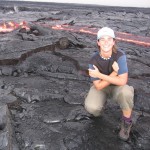
Rebecca Carey
Volcanologist
ARC Centre of Excellence in Ore Deposits
I grew up in outback Australia and had a rock quarry on my property. I went to the quarry at every opportunity to explore for “treasure”, including crystals of quartz and other minerals, for my rock collection. From that point on I knew I wanted to become a geologist.
I always enjoyed science and I was very lucky to have encouraging science teachers at high school and college. I went to the University of Tasmania for my Bachelor of Science degree and focused on Earth Science, but I was lucky enough to do the third year of my degree at the University of Hawaii in the USA. That year I got to see fresh molten lava multiple times! In fact we were able to approach the lava, scoop it up with a hammer and even cook our lunch on it! At that point I knew that studying volcanic eruptions was going to be the focus of my career.
I returned to UTAS to do an Honours project and then went back to the University of Hawaii for a PhD project focused on a historic eruption of an Icelandic volcano called Askja. I spent 2-3 months in the field every year collecting measurements, data and rocks, taking them back to the laboratory for further analysis.
When I left Hawaii after my PhD to start a post-doc in California, Kilauea volcano on Hawaii begun to explosively erupt! So I returned to Hawaii for more field work (I unfortunately did not see an explosion!) and those eruptions became the focus of research during my postdoctoral period.
Currently I study eruptions that happen on the seafloor. In particular I am interested in how the water depth influences the explosivity of volcanic eruptions. I collect my samples by participating in research cruises with remotely operated vehicles tethered to the ship, and human operated submarines. I have been down in a submarine to 1000 metres water depth! Scary but cool. I analyse these samples with microscopes at the University of Tasmania, and the Australian Synchrotron in Victoria.
100% of terrestrial Earth and Mars has been mapped, however only 10% of Earth’s ocean floor has been mapped, so there is lots to discover!
For more information: www.utas.edu.au/codes